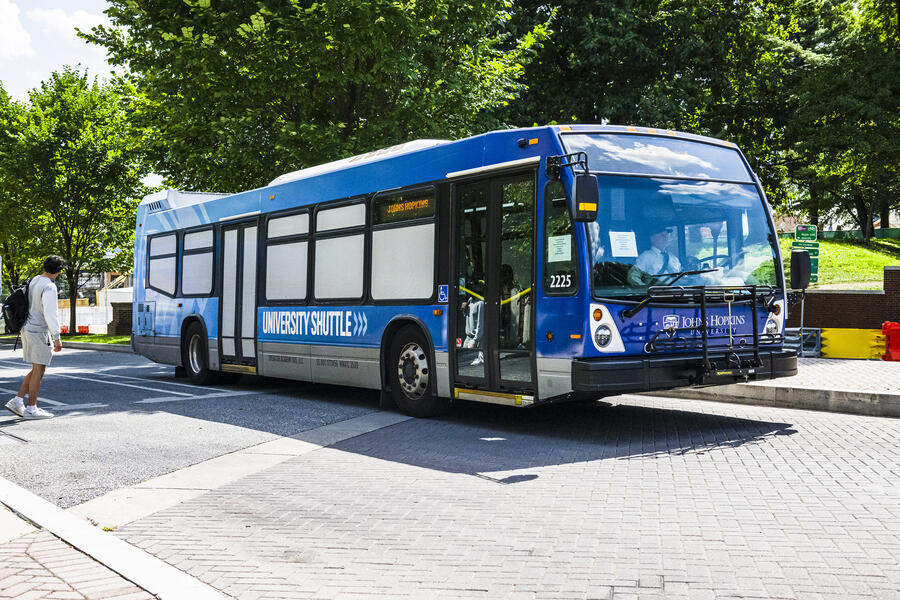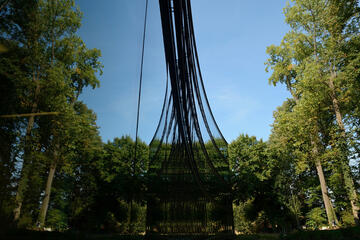Johns Hopkins University will begin electrifying its busiest bus route early next year, putting the university on track to meet the ambitious transportation and mobility goals established by its newly released Climate Action and Sustainability Plan.
The first wave of all-electric, fully accessible buses is anticipated to start running along the Homewood-Peabody-JHMI shuttle route in early 2025. A $1.5 million heavy duty, zero-emission vehicle grant from the Maryland Energy Administration will help the university start replacing its diesel fleet by offsetting the $5.5 million sticker price for the first five buses. The new buses are expected to be operational for at least 12 years—significantly reducing emissions in the overburdened and underserved communities along the route, per the award.
Each bus is also eligible for a $40,000 tax rebate from federal Inflation Reduction Act incentives. An additional five buses should be online by early 2027, according to Greg Smith, director of transportation services. By 2030, all newly purchased university vehicles, from golf carts to buses, are slated to be electric.
The Homewood-Peabody-JHMI fleet is one of the most visible signs of the new sustainability plan, which calls for net-zero emissions by 2040 in part by phasing out on-campus fossil fuels. JHU currently operates 12 diesel buses along the route, carrying more than 3,000 riders per weekday. Replacing the diesel buses with 10 fully electric buses will eliminate 741 metric tons of carbon dioxide from the air in Baltimore each year, said Julian Goresko, director of sustainability.

Image credit: Beth Fritzinger / Johns Hopkins University
"Clean transportation is a hallmark of our plan, reflecting our commitments to climate action, improved health outcomes, and a deep commitment to addressing community issues like air and noise pollution in Baltimore," Goresko said.
Transportation accounts for 25% of Baltimore's greenhouse gas emissions and is a primary contributor to regional air quality, making the reduction of these emissions a critical component of JHU's action on climate and environmental justice, according to the Climate Action and Sustainability Plan.
The imminent arrival of the buses represents several years' worth of work by Smith and his team, who spent much of this week in St. Cloud, Minnesota, inspecting the first bus as it came off the assembly line at the New Flyer company. The other four buses in the first batch are in varying stages along the production line, and buyers have to secure their spots in the line at least a year in advance, said Smith, who has been working on this project since early 2021.
"It's not like cars where they're rolling off the assembly line every three minutes or whatever—I think every six hours, they move the line one station," Smith said. "It's a fascinating process."
Although they won't hit the road until early next year, the buses will begin arriving in November, with time built into the rollout to get necessary infrastructure in place (think state inspections, securing insurance, and building charging stations) and to give drivers time to train on the new equipment.
Smith likens the interiors of the new buses to airport shuttles, with seating around the outer walls of the bus with seats facing in. Each will seat 33 riders but they can transport up to 60 people when some riders stand. The buses are each equipped with mechanical lifts that will allow riders in wheelchairs to easily access the shuttle. Once inside, they will be able to sit in their wheelchairs while riding the shuttle, using a self-operating locking system to hold wheelchairs in place when the bus is in motion.
The 13-stop route that runs from 6 a.m. to 12:30 a.m. on weekdays connects the university's two primary campuses—Homewood in North Baltimore and the East Baltimore medical campus—as well as the Peabody Institute in Baltimore's Mount Vernon neighborhood and residential neighborhoods along the way where many Hopkins students, faculty, and staff live. The route also provides limited weekend service.
It has taken several years of planning to bring Hopkins' first electric buses to Baltimore, and Smith said the university's transportation team has worked closely with its counterparts in Baltimore City, where a pilot program with electric buses is underway, and at Baltimore/Washington International Thurgood Marshall Airport, where some electric buses are already in use. Locally, it's a relatively small club, Smith says, and everyone is eager to share lessons learned to bring cleaner air to Baltimore.
Posted in University News
Tagged sustainability, transportation, climate change, office of sustainability









